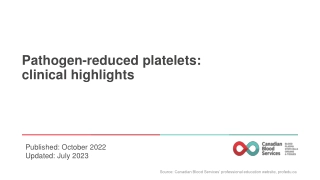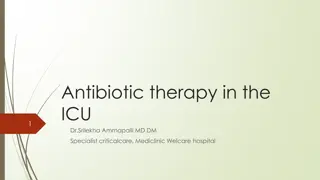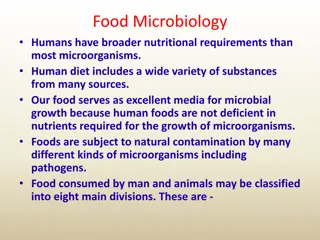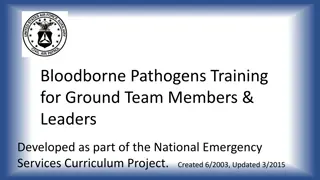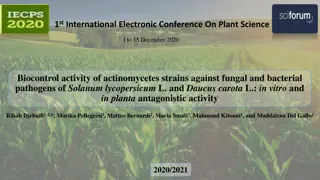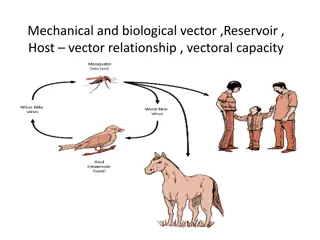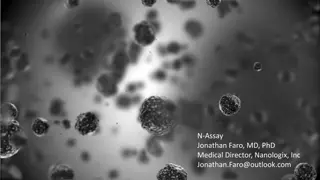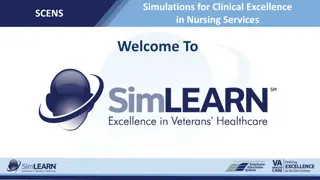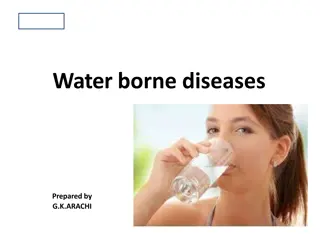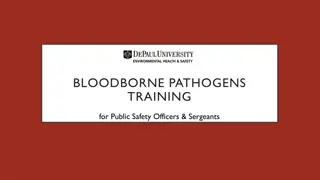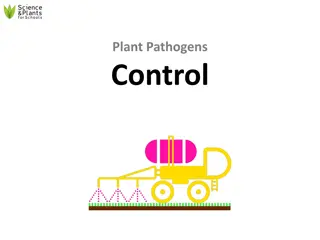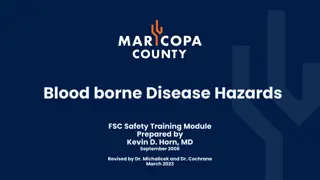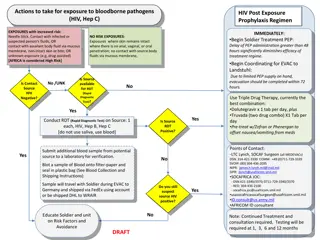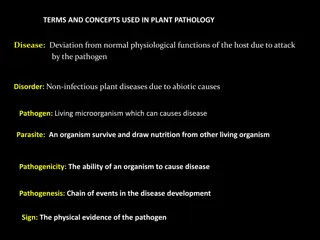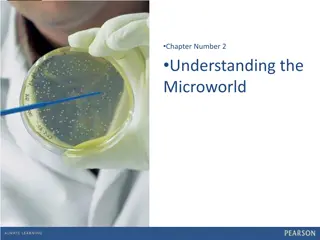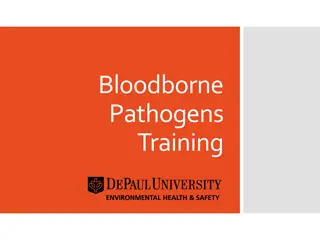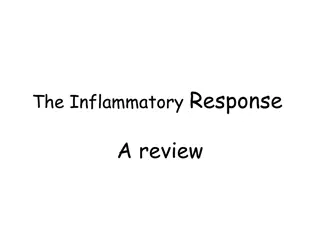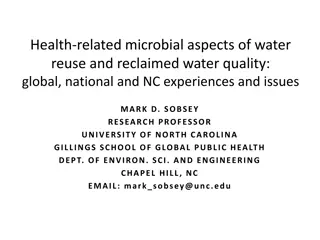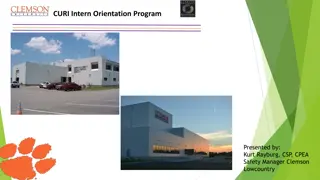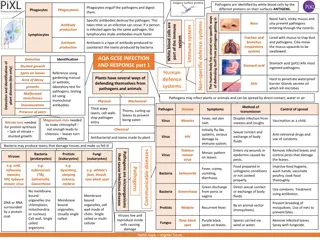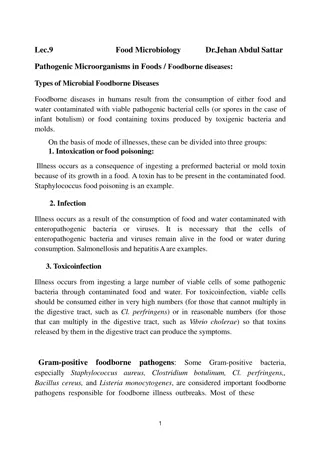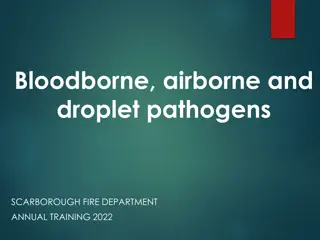Pathogen-reduced platelets: clinical highlights
Pathogen-reduced platelets play a crucial role in reducing the risk of transfusion-transmitted infections through pathogen inactivation technology (PIT). This technology provides an additional layer of safety against various pathogens including viruses, bacteria, protozoa, and leukocytes. Platelet c
2 views • 17 slides
Surgical Prophylaxis and Antimicrobial Selection Guidelines in Surgery
Surgical prophylaxis involves administering antibiotics before contamination of previously sterile tissues to prevent infections. Common pathogens in surgical site infections include skin flora like S. aureus. Antimicrobial selection is based on the surgical procedure, likely pathogens, and safety c
4 views • 19 slides
Understanding Antibiotic Therapy in the ICU: Strategies and Considerations
Delve into the world of antibiotic therapy in the intensive care unit (ICU) with a focus on identifying the enemy pathogens, selecting the appropriate antibiotics, and formulating effective treatment plans. Explore the nuances of Gram-positive and Gram-negative bacteria, along with other key bacteri
3 views • 76 slides
A Scientific Approach to Pandemic Preparedness
Barney S. Graham, MD, PhD, outlines a scientific framework for epidemic and pandemic research preparedness to achieve fast and equitable access to high-quality vaccines for future pandemics. The discussion covers new human viral pathogens, 21st-century viral threats, viral taxonomy, and a prototype
0 views • 16 slides
Understanding Vibrio and Related Organisms in Medical Bacteriology
Vibrio, Aeromonas, and Plesiomonas are gram-negative bacilli commonly found in water sources, causing gastrointestinal diseases. They exhibit similarities to Enterobacteriaceae but with distinct characteristics such as polar flagella and being oxidase-positive. Vibrios like V. cholerae are crucial h
1 views • 25 slides
Understanding Vaccines and Immunization
Explore the world of vaccines and immunization, learning about active and passive immunity, childhood and adult immunization schedules, common vaccines, contraindications, adverse effects, and the importance of immunization in preventing diseases. Discover the process of immunization and how it stim
2 views • 27 slides
Understanding Bacterial Pathogenesis: Key Concepts and Factors
Bacterial pathogenesis involves the ability of certain bacteria to cause disease by attributes such as transmissibility, adherence, motility, invasion, and toxigenicity. Pathogens can exploit host defenses, while virulence determines the severity of infection. Learn about opportunistic pathogens, no
7 views • 36 slides
Comprehensive Online Competency Module Platform for Healthcare Professionals
A detailed overview of a comprehensive online competency module platform catering to healthcare professionals, offering specialized modules on neonatal sedation, pediatric sedation, moderate sedation, deep sedation, bloodborne pathogens, fire safety, fluoroscopy, life support, and more. Features inc
4 views • 9 slides
Staining techniques
Explore a series of images illustrating various staining techniques used in histopathology, including fixation, different types of staining methods like Gram staining and acid-fast staining, as well as vital and supra-vital staining. Learn about the principles and applications of these techniques in
2 views • 42 slides
Understanding Pneumonia: Causes, Classification, and Risk Factors
Pneumonia is an infection of the lower respiratory tract that can be classified anatomically and etiologically. The common causes include bacterial, viral, and fungal pathogens, as well as aspiration pneumonia. Factors such as immune deficiency, overcrowding, and poor hygiene can increase the risk o
10 views • 37 slides
Understanding Food Microbiology: Sources of Contamination
Humans have broader nutritional requirements than most microorganisms. The human diet includes a wide variety of substances, making our food excellent media for microbial growth. Natural contamination of food by various microorganisms, including pathogens, is common. Food consumed by humans and anim
0 views • 51 slides
Bloodborne Pathogens Training Overview for Ground Team Members
Understanding bloodborne pathogens is crucial for ground team members to protect themselves and others. This training covers what bloodborne pathogens are, focusing on Hepatitis B Virus (HBV) and Human Immunodeficiency Virus (HIV), their symptoms, transmission risks, and prevention methods. HBV fact
0 views • 29 slides
Biocontrol Activity of Actinomycetes Against Pathogens of Tomato and Carrot
Plants face various stresses due to climate change, making them vulnerable to pathogens. Actinomycetes, such as Streptomyces, are beneficial soil bacteria with antimicrobial properties that can promote plant growth and suppress diseases. Research explores their antagonistic activity against fungal a
0 views • 13 slides
Vector Relationships and Pathogen Transmission
Understanding mechanical and biological vectors, reservoir hosts, and their role in disease transmission is crucial for effective disease control. Mechanical vectors like flies can transfer pathogens without getting infected, while biological vectors like mosquitoes carry pathogens that reproduce in
1 views • 5 slides
Revolutionary N-Assay: Transforming Pathogen Detection in Healthcare
Innovative N-Assay developed by Jonathan Faro, MD, PhD, offers a faster, more accurate, and cost-effective solution for detecting bacterial pathogens in healthcare settings. Unlike traditional assays, N-Assay differentiates between viable and non-viable pathogens, provides information on antibiotic
1 views • 15 slides
Clinical Excellence in Hepatitis C Nursing: SCENS Program Overview
Demonstrating competency in infection control, abdominal assessment, specimen collection, and communication is crucial in nursing care for patients with Hepatitis C. The SCENS program focuses on key learning objectives to enhance clinical proficiency, address potential issues, and understand the com
0 views • 12 slides
Understanding Water-borne Diseases and Pathogens
Drinking contaminated water can lead to water-borne diseases, causing millions of deaths annually, especially in developing countries. Potable water is essential for health and development, as water-related diseases arise from inadequate water quality and poor sanitation practices. Various pathogens
1 views • 28 slides
Workplace Safety and OSHA Regulations for Phlebotomists
Learn about the importance of workplace safety and OSHA regulations for phlebotomists, including tips on cleanliness, following guidelines, and penalties for violations. It covers the critical need to prevent injuries and exposure to bloodborne illnesses in the workplace through proper practices and
0 views • 29 slides
Bloodborne Pathogens Training for Public Safety Officers & Sergeants
Bloodborne pathogens (BBPs) are pathogenic microorganisms found in human blood that can cause diseases like HIV, Hepatitis B, and Hepatitis C. Public safety officers and sergeants face occupational exposure to BBPs and should follow OSHA's BBP Standard to protect themselves. Training, vaccinations,
0 views • 41 slides
Understanding the Genus Neisseria: Pathogens and Characteristics
The genus Neisseria comprises important pathogens such as Neisseria meningitidis and Neisseria gonorrhoeae, causing meningitis, gonorrhea, and other infections. This article explores their characteristics, differentiation from non-pathogenic species, properties like Gram-negative diplococci, and ser
0 views • 32 slides
Understanding OSHA Bloodborne Pathogens Training and Hepatitis B Virus
Covering the basics of OSHA Bloodborne Pathogens Standard, this training material provides essential information on bloodborne pathogens, including Hepatitis B Virus (HBV). It emphasizes the importance of training for individuals with occupational exposure, outlining crucial topics such as Hepatitis
2 views • 56 slides
Understanding Host-Parasite Relationship in Microbiology
In microbiology, the host-parasite relationship is crucial for understanding diseases caused by pathogens. This lecture covers definitions of terms like pathogenicity, pathogen, disease, resistance, susceptibility, infection, virulence, and transmissibility. It also delves into the division of host
0 views • 16 slides
Understanding and Controlling Plant Pathogens for Sustainable Agriculture
Plants are essential for our survival, providing food, materials, and clean air. However, they are susceptible to diseases caused by pathogens like bacteria, viruses, fungi, and protists. These diseases can lead to reduced crop yields and increased costs. To control plant pathogens and pests, method
5 views • 28 slides
Blood-Borne Disease Hazards in Healthcare Settings
Healthcare workers face risks of exposure to bloodborne pathogens like HIV, HBV, and HCV. This training module covers sources and routes of exposure, emphasizing the importance of universal precautions. Specific focus is given to Hepatitis B and C viruses, their impact on the liver, transmission met
0 views • 30 slides
Bloodborne Pathogens Exposure: HIV Post Exposure Prophylaxis Regimen
Take immediate action for exposure to bloodborne pathogens like HIV and Hepatitis C through a post-exposure prophylaxis (PEP) regimen. Administer PEP within 48 hours for increased-risk exposures like needle sticks or contact with infected fluids. Coordinate evacuation if needed and conduct Rapid Dia
0 views • 5 slides
Overview of Pathogenesis in Infectious Diseases
This content provides valuable information on the pathogenesis of infectious diseases, including definitions, phases of disease progression, types of infections, acute vs. chronic diseases, signs vs. symptoms, steps in pathogenesis, and ways pathogens can enter the body. It discusses the importance
0 views • 15 slides
Essential Terms and Concepts in Plant Pathology
Plant pathology involves understanding the various terms and concepts related to plant diseases, pathogens, symptoms, and more. From diseases caused by pathogens like Black Wart of Potato to the importance of inoculum potential and hypersensitivity, this field encompasses a wide range of factors tha
0 views • 5 slides
The Significance of Microbiology in Health Sciences and Beyond
Microbiology plays a crucial role in understanding small living organisms, including pathogens and non-pathogens. Studying microbiology is essential due to the prevalence of microorganisms in our body, their role in the food chain, and their applications in various industries like food, beverage, an
0 views • 19 slides
Understanding the Microworld: Factors Affecting Foodborne Pathogens
This chapter delves into the microworld of microorganisms and pathogens that can contaminate food, leading to foodborne illnesses. It covers key terms such as bacteria, viruses, parasites, and fungi, along with topics on preventing contamination, understanding spores, and the temperature danger zone
0 views • 25 slides
Bloodborne Pathogens Training Overview
This presentation provides essential information on Bloodborne Pathogens Training, emphasizing the importance of understanding and managing exposure to potentially infectious materials. It covers topics such as the Bloodborne Pathogens Standard, Exposure Control Plan, hazards associated with BBPs, a
0 views • 20 slides
Understanding the Inflammatory Response Mechanism
The inflammatory response is a crucial defense mechanism of the immune system. It comprises three lines of defense aimed at protecting the body from harmful pathogens. When a barrier is breached, such as by a splinter carrying bacteria, the inflammatory process is initiated. This includes the releas
0 views • 25 slides
Understanding Health Risks in Reclaimed Water and Water Reuse
Exploring the microbial aspects of reclaimed water and wastewater reuse is crucial for public health. Pathogenic microorganisms present in wastewater, such as bacteria, viruses, and parasites, can lead to gastrointestinal and systemic illnesses in humans. Proper removal and inactivation of these pat
0 views • 25 slides
Understanding the Immune System: Defenses Against Pathogens
Delve into the intricate workings of the immune system as it fights off pathogens to protect the body. Explore how external defenses like tears, saliva, and skin, along with internal defenses like inflammation and white blood cells, work together to maintain homeostasis and safeguard against sicknes
0 views • 21 slides
Molecular Investigation of Zoonotic Pathogens in Rodents of Iran
This presentation explores the molecular investigation of zoonotic pathogens such as Coxiella burnetii, Bartonella, Rickettsia, Ehrlichia, Brucella, and Borrelia in rodents of Iran. It discusses the background of zoonotic disease pathogens, disease reservoirs, characteristics of Coxiella burnetii, v
0 views • 58 slides
Comprehensive CURI Intern Orientation Program Overview
The CURI Intern Orientation Program, led by Safety Manager Kurt Rayburg, aims to provide interns with a sound understanding of safety processes and campus environments at Clemson University. The program emphasizes personal responsibility for safety, adherence to safety rules, familiarity with emerge
0 views • 10 slides
Understanding Pathogens and Immune Response Mechanisms
Pathogens, such as bacteria, viruses, and fungi, can cause infectious diseases in humans, animals, and plants. The immune system defends against these pathogens through various mechanisms, including the production of antibodies, phagocytosis, and the activation of specific defense cells like white b
0 views • 4 slides
Understanding Foodborne Diseases and Pathogenic Microorganisms in Foods
Foodborne diseases in humans are caused by consuming contaminated food or water containing pathogenic microorganisms or toxins. These diseases can be categorized into intoxication, infection, and toxicoinfection, each with distinct modes of illness. Pathogens like Staphylococcus aureus, Clostridium
0 views • 5 slides
Understanding Infectious Diseases and Prevention Strategies
Infectious diseases are caused by pathogens like bacteria, viruses, parasites, or fungi invading the body. These diseases can spread from person to person and sometimes from animals to humans. Common characteristics include potential severe outcomes, transmission modes, and the role of pathogens. Th
0 views • 27 slides
Understanding Bloodborne, Airborne, and Droplet Pathogens in Workplace Training
Explore the importance of annual training for employees in contact with blood or blood products, as mandated by OSHA. Learn about occupational exposure, exposure control plans, disease processes, and types of diseases caused by microorganisms. Gain insights into normal flora, infectious diseases, an
0 views • 76 slides
Insights into the Career Journey of Jarrod Leland at Novozymes
Jarrod Leland, a Ph.D. holder in Entomology from VT, transitioned from being a Government Scientist to a Scientist at Novozymes focusing on insect pathogens. With vast experience in the field, he now leads a team of 20 individuals, emphasizing the use of insect pathogens as alternatives to chemical
0 views • 17 slides
